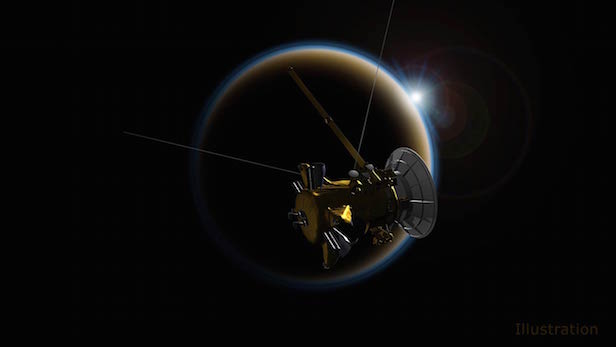Cassini to make final close approach of Titan this weekend
The flyby marks the mission’s final opportunity for up-close observations of the lakes and seas of liquid hydrocarbons that spread across the moon’s northern polar region

Cassini will make its final close flyby of Saturn’s moon Titan on April 21 (PDT), using its radar to reveal the moon’s surface lakes and seas one last time. Image credit: NASA/JPL-Caltech
NASA’s Cassini spacecraft will make its final close flyby of Saturn’s haze-enshrouded moon Titan this weekend. The flyby marks the mission’s final opportunity for up-close observations of the lakes and seas of liquid hydrocarbons that spread across the moon’s northern polar region, and the last chance to use its powerful radar to pierce the haze and make detailed images of the surface.
Closest approach to Titan is planned for 06:08am UTC on 21 April. During the encounter, Cassini will pass as close as 979 kilometres (608 miles) above Titan’s surface at a speed of about 21,000 kilometres per hour (13,000 miles per hour).
The flyby is also the gateway to Cassini’s Grand Finale – a final set of 22 orbits that pass between the planet and its rings, ending with a plunge into Saturn on 15 September that will end the mission. During the close pass on 21 April, Titan’s gravity will bend Cassini’s orbit around Saturn, shrinking it slightly, so that instead of passing just outside the rings, the spacecraft will begin its finale dives which pass just inside the rings.
The flyby is Cassini’s 127th targeted encounter with Titan. A targeted flyby is one for which the spacecraft uses its rocket engine or thrusters to accurately aim toward the encounter.
Cassini’s radar instrument will look for changes in Titan’s methane lakes and seas, and attempt for the first (and last) time to study the depth and composition of Titan’s smaller lakes. The radar instrument will also search a final time for Titan’s ‘magic island’, a mysterious feature in one of the moon’s seas that changed in appearance over the course of several flybys. Scientists hope to gain additional insights to help them determine whether the feature is waves, bubbles, floating debris, or something else entirely.
Keep up to date with the latest space news in All About Space – available every month for just £4.99. Alternatively you can subscribe here for a fraction of the price!




